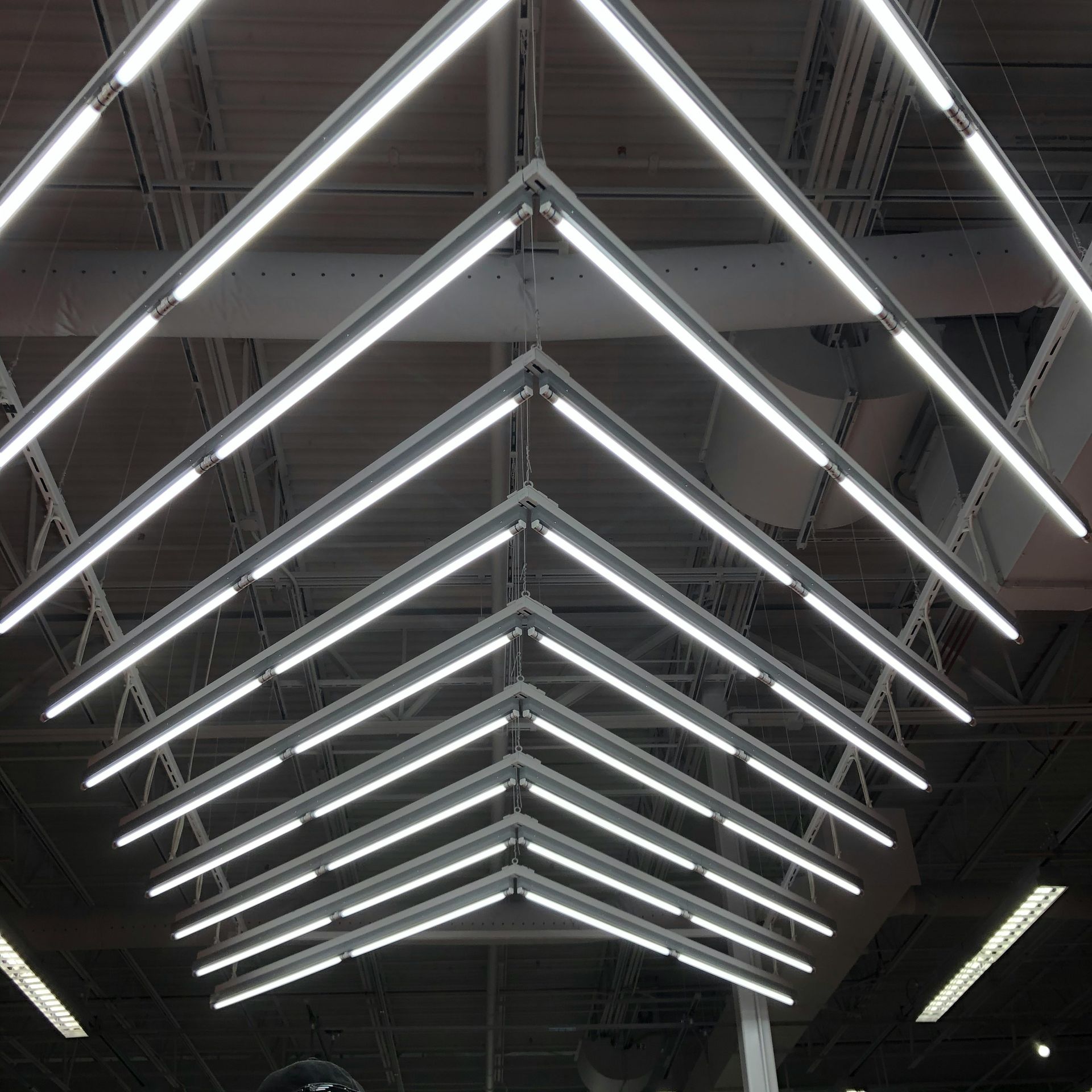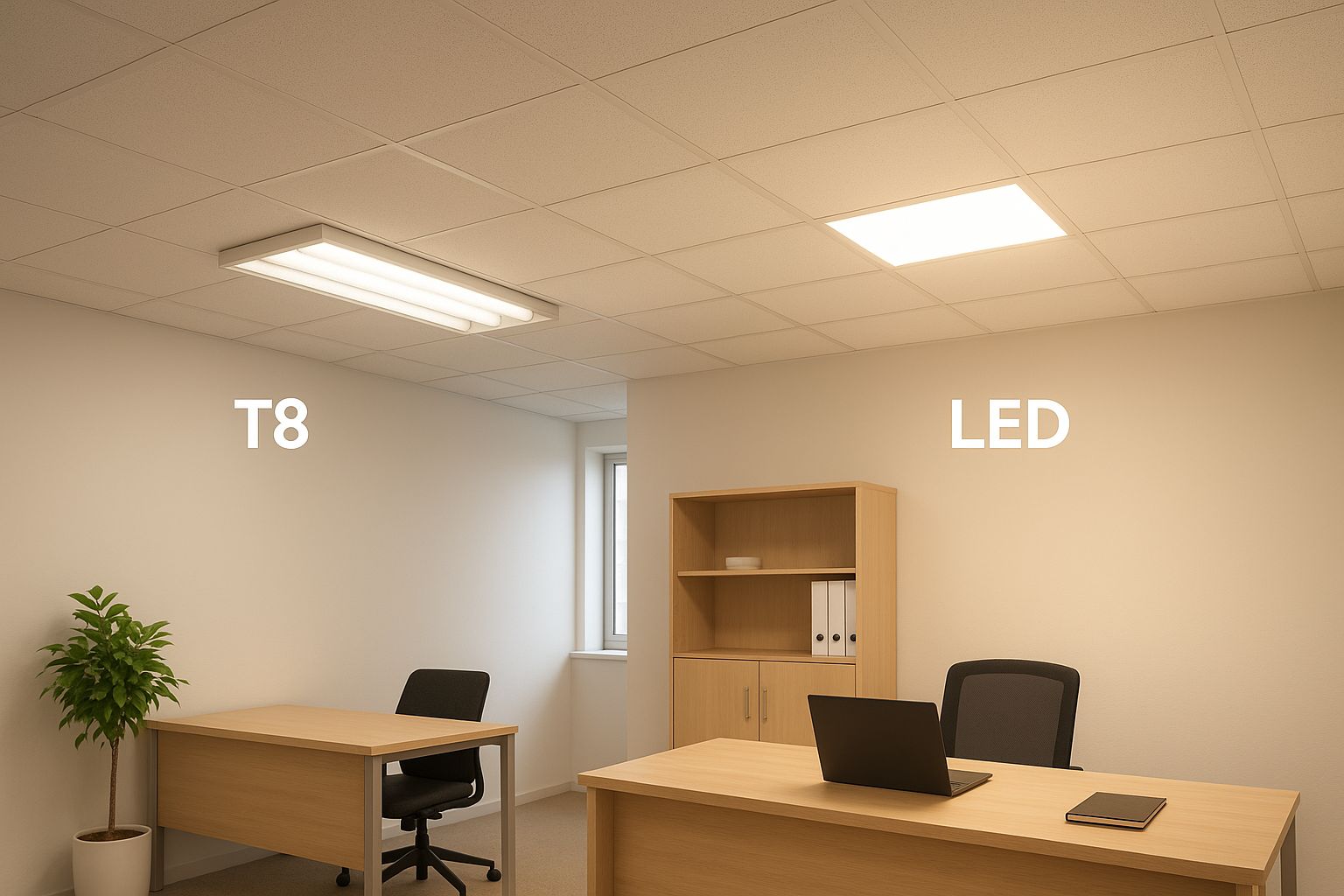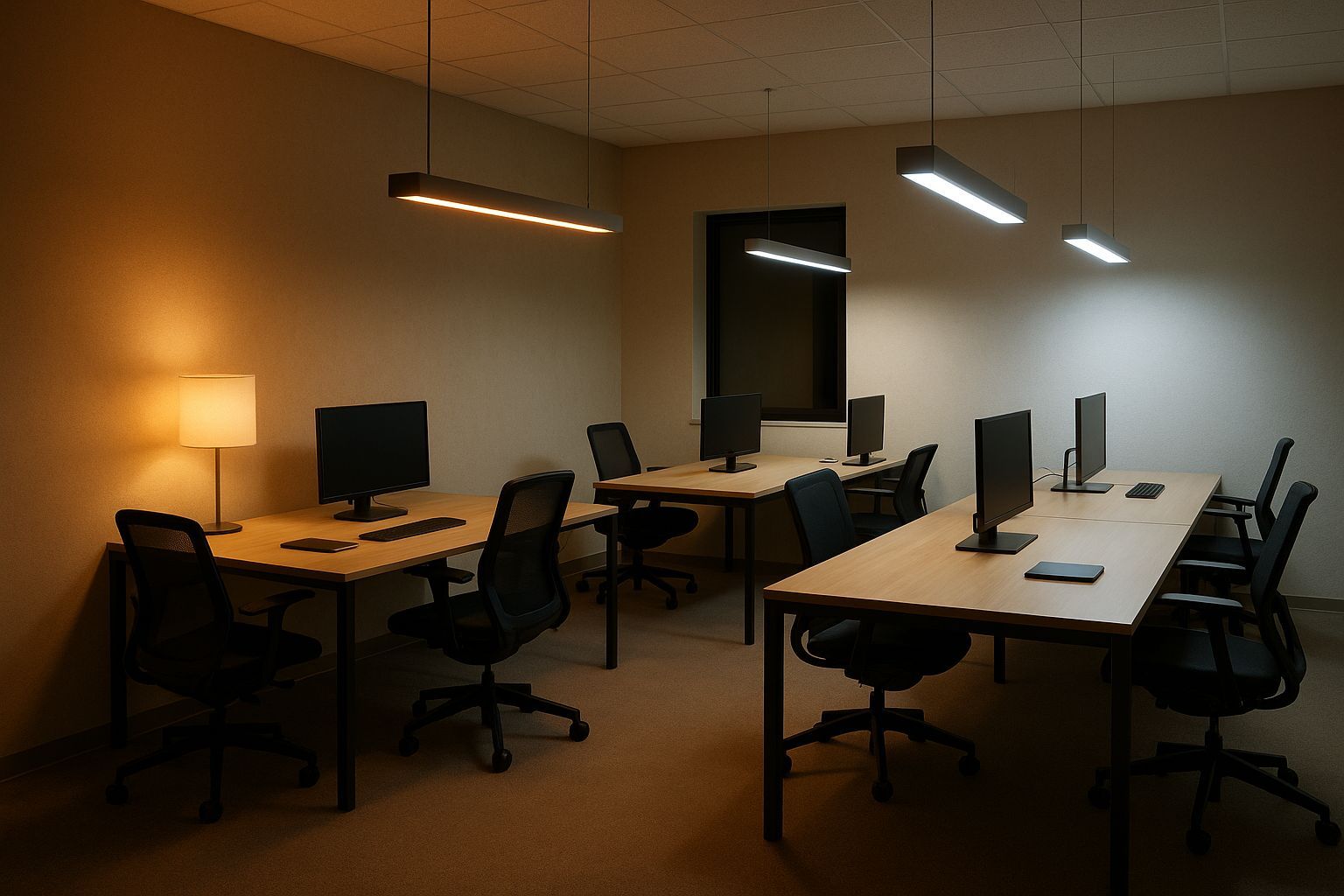How to Retrofit Outdoor Fixtures with LED Lighting
How to Retrofit Outdoor Fixtures with LED Lighting
Retrofitting outdoor fixtures with LED lighting is a smart way to save energy, reduce costs, and improve lighting quality without replacing entire fixtures. LEDs consume up to 90% less electricity than traditional bulbs and last up to 50,000 hours, cutting maintenance costs significantly. By upgrading existing fixtures like wall packs, parking lot lights, floodlights, and pathway lights with LED retrofit kits, businesses can meet energy standards, lower utility bills, and enhance safety.
Key Takeaways:
- Energy Savings: LEDs use 25%-90% less energy than older lighting systems.
- Cost Efficiency: Reduced electricity bills and fewer replacements save money over time.
- Durability: LEDs last up to 50,000 hours, reducing maintenance disruptions.
- Environmental Impact: Nationwide LED adoption could save $30 billion in energy costs by 2027.
- Compliance: Aligns with energy codes like California Title 24 and ASHRAE 90.1.
Switching to LEDs not only improves efficiency but also supports sustainability goals. Whether you opt for plug-and-play kits or ballast-bypass retrofits, the process is manageable with proper tools and safety precautions. For larger or complex projects, hiring a licensed electrician ensures safety and compliance.
Exterior Recessed Light Upgrade - Retrofit old-school Lightolier to new LED's by RAB
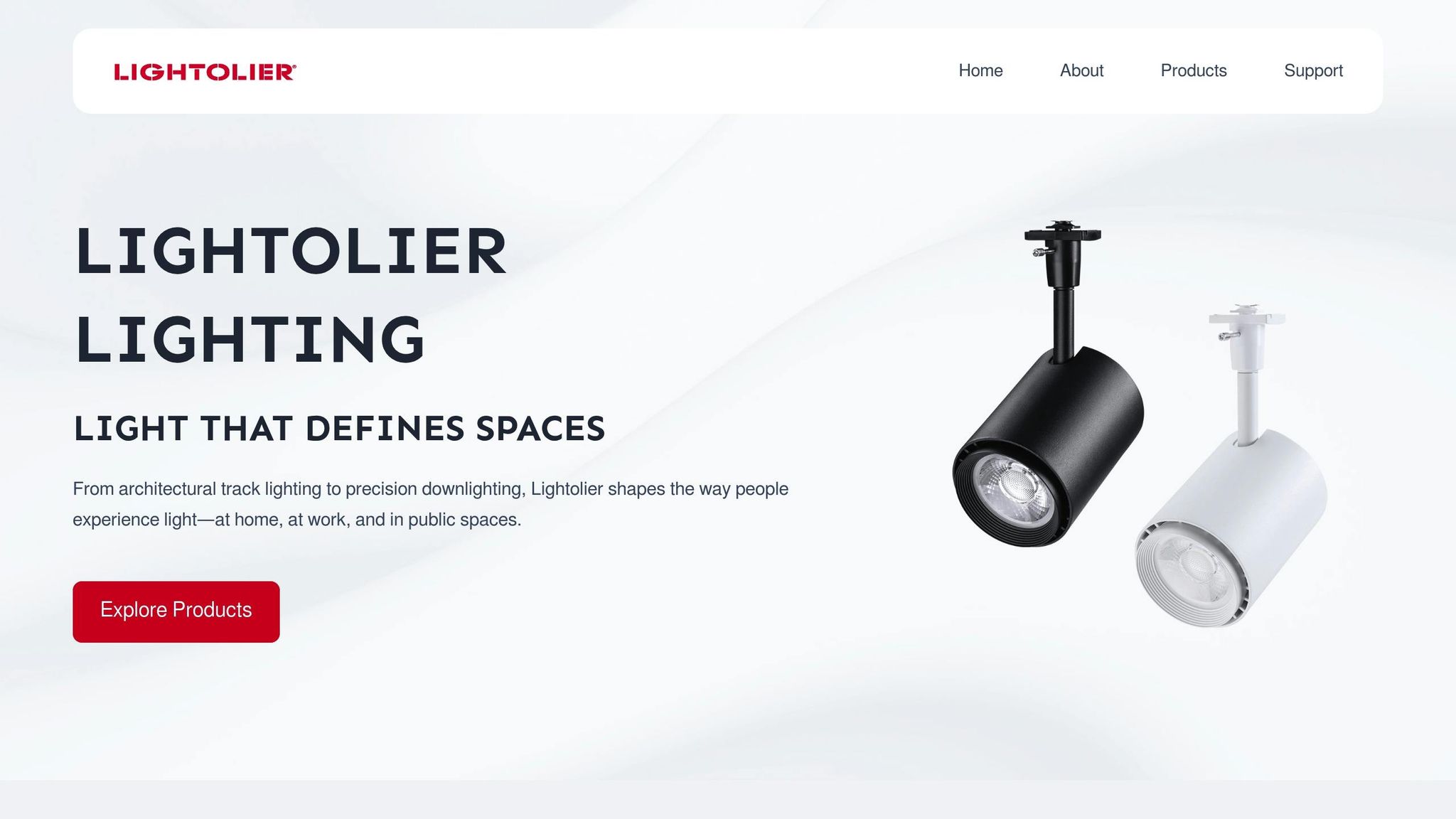
LED Retrofit Solutions Explained
LED retrofitting is all about upgrading outdated lighting systems with energy-efficient LED technology while keeping the existing fixtures intact. This approach not only reduces energy consumption but also helps save on costs. Considering that commercial buildings are responsible for 40% of energy use in the U.S., retrofitting offers a practical way to cut down on energy bills. The process involves replacing old bulbs, ballasts, and drivers with LED alternatives that fit into the current fixtures. This means you don't have to replace entire fixtures, yet you still enjoy immediate energy savings and improved lighting quality. In fact, switching to LED lighting can lower energy use by up to 75%. Let’s take a closer look at outdoor fixtures that are ideal for these upgrades.
Outdoor Fixtures That Work with LED Retrofits
Many commercial outdoor fixtures are perfect candidates for LED retrofits. Common examples include:
- Wall pack fixtures mounted on building exteriors.
- Parking lot fixtures, such as shoebox-style luminaires and cobra head streetlights.
- Floodlights used for security purposes.
These fixtures can be upgraded using LED retrofit kits, which improve lighting performance while utilizing the existing infrastructure.
Other great candidates include canopy lights found at gas stations, drive-throughs, and covered walkways. These fixtures protect LED components from the elements while enhancing visibility and safety. Bollard lights and pathway fixtures can also be retrofitted, though their compact designs may require more specialized LED components.
For larger-scale applications, high-mast lighting systems- used in parking lots, sports venues, and industrial facilities - benefit greatly from LED retrofits. Since these fixtures are often hard to access, the reduced maintenance needs of LEDs make them an excellent choice.
Main Benefits of LED Retrofitting
The biggest advantage of LED retrofitting is energy efficiency. LEDs consume 25% to 80% less energy than traditional lighting, depending on the type of fixture being replaced. This leads to noticeable reductions in monthly electricity bills.
Another key benefit is heat management. CFLs convert about 80% of their energy into heat, while LEDs emit almost no heat. This makes LEDs especially useful for outdoor applications, where excessive heat can damage fixtures and shorten their lifespan. Plus, lower heat output reduces strain on cooling systems in nearby buildings.
LEDs also outperform traditional lighting in cold weather, operating about 5% better in low temperatures. This makes them ideal for outdoor environments.
"Quality outdoor lighting contributes to a more inviting environment for both customers and employees, and helps ensure their safety." - QSR magazine
The long lifespan of LED fixtures - ranging from 50,000 to 100,000 hours - significantly cuts down on maintenance costs. And since LEDs are free of toxic materials and meet modern efficiency standards, they align with sustainability goals.
"Upgrading to LED lights will reduce energy costs and greenhouse gas (GHG) emissions, making your property more environmentally friendly and responsible with a smaller carbon footprint." - US LED Blog
These benefits make LED retrofitting a smart choice for improving lighting while supporting energy conservation and environmental responsibility.
LED Performance Factors to Consider
To maximize the benefits of LED retrofits, it's important to understand key performance metrics:
- Brightness (lumens): This measures how much light a fixture produces. For example, outdoor security lights typically require 1,000–3,000 lumens, while pathway lighting may only need 200–800 lumens. Matching the lumen output to the application ensures effective lighting without wasting energy.
- Color temperature: Measured in Kelvins (K), this determines whether light appears warm or cool. Warmer tones (2700K–3000K) create a cozy feel, while cooler tones (4000K–5000K) are better for visibility and security. Most commercial outdoor settings benefit from the cooler range.
- Energy efficiency ratings: Look for Energy Star -certified fixtures to ensure maximum energy savings.
- Weather resistance: IP ratings indicate how well fixtures resist dust and moisture. For example, IP65-rated fixtures can handle water jets, while IP67-rated ones can withstand temporary water immersion. Higher ratings are especially important in harsh climates.
- Beam angle: This affects how light is distributed. Narrow angles (15–30°) are ideal for accent lighting, while wider angles (60–120°) work well for area and security lighting. Adjustable beam angles add flexibility for different needs.
- Dimming compatibility: Many LED retrofits work with existing dimming systems or can be upgraded for smart controls. Features like motion sensing and daylight harvesting can further boost energy savings.
- Operating temperature range: LEDs perform reliably in a wide range of temperatures, from -40°F to 140°F. Be sure to choose fixtures that match your local climate conditions.
Tools, Materials, and Safety Requirements
Before diving into your LED retrofit project, make sure you’ve got all the tools and materials ready to go. Being well-prepared with the right equipment ensures a smoother and safer installation process.
Required Tools and Materials
For a basic LED retrofit, you’ll need a few essential tools. Start with wire strippers to prep electrical connections and a voltage tester or multimeter to confirm the power is off. Keep a set of screwdrivers(both Phillips and flathead) handy, along with a drill for mounting fixtures. If you’re working on elevated outdoor lights, use a sturdy ladder rated to support your weight plus any tools or materials you’ll be carrying.
The centerpiece of your project will be an LED retrofit kit, which typically includes LED modules, drivers, and mounting hardware tailored to your specific fixture. Other must-haves include electrical tape for securing connections and wire connectors(like wire nuts or terminal blocks) for safely joining wires.
For more complicated installations, you might need additional items like heat shrink tubing and a soldering iron to create weatherproof connections. To further protect your setup, consider using weatherproof sealants, conduit to shield wiring, and replacement gaskets or seals to maintain the fixture’s resistance to the elements.
Safety Steps
When it comes to retrofitting, safety should always come first - especially electrical safety. Start by disconnecting the power at the breaker or removing the fuse for the circuit you’re working on. Then, double-check with a voltage tester to confirm there’s no current running through the wires. Turning off a wall switch alone isn’t enough; you need to cut power at the source.
"With any retrofitting there is always the danger of electrocution, so be sure to check that the power is disconnected before you start. If it's not, simply turn off the power from the breaker before installation."
"Touching a live wire or incorrectly connecting wires can cause electrical shocks, which can be fatal."
Use insulated tools and select components made with insulating materials like glass, paper, or Teflon to minimize the risk of exposure to live wires. For outdoor projects, make sure all components, including the lights, are rated for external use and can withstand your area’s climate. Wiring should be buried at least 18 inches underground for protection, and using conduit adds an extra layer of defense against moisture and pests.
If your project involves outdoor circuits, Ground Fault Circuit Interrupters (GFCI) are a must. These devices significantly reduce the risk of electrical shocks in wet conditions. Also, use waterproof cords designed for outdoor environments to further enhance safety.
Avoid running lights over or near power lines, and always check your local building codes and regulations regarding outdoor electrical work. Taking these precautions will help ensure both safety and efficiency, whether you’re tackling the project yourself or considering professional help.
When to Hire a Licensed Electrician
While many LED retrofit projects are manageable for those with basic electrical knowledge, some situations require a professional’s expertise. For larger-scale projects, or if you’re unsure about circuit loads or wiring complexities, it’s best to call a licensed electrician. Outdoor installations, in particular, can be tricky due to the added challenges of weatherproofing and compliance with local codes.
One reason to bring in a pro is to ensure your system has proper surge protection, which shields LED components from power spikes. Additionally, electricians can verify that the total wattage of your LEDs is at least 20% below your power supply’s rated capacity, preventing overloads and ensuring optimal performance.
Licensed electricians also handle permits and inspections, making the whole process smoother. Their expertise not only ensures your installation is safe and up to code but also helps your LEDs perform at their best. If in doubt, professional help is always a smart investment.
Step-by-Step Retrofit Installation Guide
Approaching a retrofit project with a clear plan ensures a smooth process, better performance, and improved safety. Here's how to get started.
Check Current Fixtures and Lighting Needs
Start by evaluating your existing fixtures. Note the wattage, bulb type, and ballast details. You can usually find this information on labels attached to the fixture housing or the bulbs themselves. For outdoor fixtures, you’re likely dealing with metal halide, high-pressure sodium, or fluorescent bulbs, which typically range from 70 to over 400 watts.
Inspect the fixture housing thoroughly. Pay attention to mounting brackets, electrical connections, and weatherproof seals. Look for cracks, corrosion, or other damage, especially around joints where water could seep in. If the damage is severe, you may need to replace the entire fixture. Taking the time to address these issues upfront will save you from headaches later.
Next, assess the current lighting performance. Walk through the area at night to identify any dark spots, overly bright areas, or uneven light distribution. This will help you determine the appropriate lumen output and beam angles for your new LED setup, ensuring a well-lit and balanced environment.
Choose the Right LED Retrofit Option
Once you’ve assessed your fixtures, it’s time to choose the best retrofit option for your needs. The main choices are plug-and-play kits, ballast-bypass retrofits, or full fixture replacements.
- Plug-and-play retrofits (Type A): These are the simplest to install as they work with your existing ballast. Just make sure to check the LED kit’s manual for compatibility with your current ballast. This option is ideal if your ballast is in good condition.
- Ballast-bypass retrofits (Type B): This approach involves removing or bypassing the ballast entirely. While it’s more complex, it eliminates the risk of future ballast failures and reduces maintenance. Always consult a licensed electrician to ensure compliance with local codes when rewiring.
When deciding on your LED solution, consider the required brightness and wattage for your application. For example, parking lot fixtures might need 10,000 to 20,000 lumens, while pathway lighting typically requires 2,000 to 5,000 lumens. Choose a color temperature between 4,000K and 5,000K for outdoor use to strike a balance between functionality and ambiance.
"LED Retrofitting is not only about swapping out old bulbs. It involves choosing the right LED Retrofit Kit to suit the specific location and requirements. For instance, a city street might call for a different color temperature and beam angle compared to a retail parking lot." - Dara Greaney, CEO of LED Light Expert
Ensure the retrofit kit has certifications like UL, ETL, Energy Star, or DLC, which guarantee safety and quality while also making you eligible for rebates. Finally, verify that the retrofit kit is compatible with your existing mounting brackets or poles for a smooth installation.
LED Retrofit Installation Steps
Before starting, turn off the power supply to the fixture. Remove the existing bulb or lamp, and if you’re working with HID lamps, make sure they’ve cooled down completely before handling them.
For a ballast-bypass retrofit, locate and disconnect the ballast. Remove it entirely, then connect the LED driver directly to the incoming power supply using the wiring diagram provided with your kit.
For plug-and-play kits, simply attach the LED module to the existing ballast as per the instructions.
Secure all electrical connections with proper wire connectors and electrical tape to ensure safety. Once the retrofit is complete, attach warning labels to the fixture to inform future electricians about the modifications.
Mount the LED module following the manufacturer’s guidelines. Adjust the mounting brackets to optimize light distribution. Before sealing the fixture, restore power and test the setup to ensure the LED operates correctly with even illumination.
Performance Optimization Tips
After installation, focus on fine-tuning the setup for maximum efficiency and performance. Consider integrating motion sensors, photocells, or smart timers to reduce energy use by up to 40%.
Adjust the beam angles and aim the fixtures carefully. Many LED retrofit kits allow for rotation or tilting to achieve optimal coverage. Proper aiming minimizes light spilling onto neighboring properties while ensuring the target area is well-lit.
Finally, confirm that the fixture and LED kit have the appropriate IP rating for outdoor use. Check weatherproof seals and mounting surfaces to protect the installation from environmental factors. And remember, rely on lumen output - not wattage - when matching brightness levels.
sbb-itb-86fe545
Calculating Energy and Cost Savings
Figuring out the financial benefits of switching to LED lighting can help make the case for your investment and guide future projects. Once you have the necessary data, the math is simple.
Energy Savings and Payback Period Calculations
To start, gather these key details: the wattage of your current fixtures, the wattage of the new LED fixtures, daily operating hours, annual operating days, and your electricity rate (in $/kWh). You can usually find your electricity rate on your utility bill, which typically ranges from $0.08 to $0.15 per kWh in the U.S.
Here’s the formula to calculate energy savings:
(Old Wattage - New Wattage) × Operating Hours per Year ÷ 1,000 = kWh saved per year
To estimate your financial savings, multiply the kWh saved by your electricity rate.
Let’s look at an example: A business replaced twenty 400W metal halide lamps with 150W LED lamps. These lights run 12 hours a day, every day of the year, with an electricity rate of $0.125 per kWh. Using the formula:
(400W - 150W) × 20 lamps × 12 hours/day × 365 days/year ÷ 1,000 = 21,900 kWh saved annually.
At $0.125 per kWh, this equals $2,737.50 in annual energy savings.
LEDs also cut down on maintenance costs. They can last up to 50,000 hours, compared to the 6,000–15,000 hours typical for metal halide lamps. For instance, replacing twenty 400W metal halide lamps (at $30 per lamp plus $50 for scaffold rental) could save you around $8,000 in maintenance costs over the 50,000-hour lifespan of the LEDs.
To calculate the payback period, divide the total retrofit cost by the combined annual energy and maintenance savings. For example, if the retrofit costs $15,000 and the annual savings are $3,500:
$15,000 ÷ $3,500 ≈ 4.3 years.
| Calculation Factor | Formula | Purpose |
|---|---|---|
| Energy Savings per Lamp | (Old Wattage - New Wattage) × Operating Hours ÷ 1,000 | Measures kWh reduction per lamp |
| Yearly Savings per Lamp | Energy Savings per Lamp × Electricity Rate | Calculates dollar savings per year |
| Payback Period | Net Cost ÷ Total Annual Savings | Determines how quickly you recover costs |
These calculations highlight the financial advantages of LED retrofits.
Available Rebates and Incentives
Rebate programs can significantly lower your upfront costs, making LED upgrades even more appealing. Current rebate amounts include:
- $4 per LED tube
- $33 per 2x4 troffer fixture
- $94 per parking garage fixture
- $53 per HID screw-in bulb
- $135 per pole light.
States in the Northeast(like New York, Massachusetts, and Pennsylvania) often offer more generous rebates, while Midwest and Northwest states(such as Illinois, Michigan, and Washington) also provide solid incentives. On the other hand, states like California, Texas, and Florida tend to have less substantial rebates.
Keep in mind that most rebate programs require pre-approval, which can take about 22 days. You’ll need to submit product specifications, energy savings calculations, and invoices. From start to finish, the process can take up to 12 weeks.
Additionally, rebate programs are increasingly tied to smart technology integration. Features like occupancy sensors, scheduled timers, and building management systems are often eligible for rebates under 2025 programs. These upgrades not only qualify for financial incentives but also help reduce energy use even further.
Check with your local utility provider to explore available rebates, and consider combining these with tax incentives for even greater savings. Consult with a tax expert to ensure you’re maximizing these benefits.
Recording Before and After Results
Documenting your retrofit results is crucial for verifying savings, supporting future projects, and meeting rebate requirements. Start by tracking your baseline energy usage using at least three months of utility data. Take "before" photos of lighting levels with a light meter. After installation, monitor your energy usage for six months, note any maintenance activities, and gather feedback on the lighting quality.
Keep both digital and physical copies of all records, including receipts, rebate paperwork, warranty information, and performance data. These records aren’t just useful for rebates - they also help with warranty claims, insurance, and optimizing future lighting investments.
Pros and Cons of LED Outdoor Retrofits
Building on earlier discussions about the technical and financial aspects, let’s dive into a clear comparison of the benefits and challenges of LED outdoor retrofits. While the positives often outweigh the hurdles, it’s crucial to anticipate potential issues to ensure a smooth upgrade process.
Advantages vs Challenges Comparison
| Advantages | Challenges |
|---|---|
| Energy Savings: LED fixtures can cut energy use by 25%–80%, with some retrofits slashing consumption by up to 85%. | Initial Investment: The upfront cost can be high, but rebates and long-term savings usually offset this. |
| Extended Lifespan: LEDs can last up to 100,000 hours. | Compatibility: Existing fixtures or dimmers may need upgrades to work with LEDs. |
| Minimal Heat Output: LEDs produce little heat, reducing strain on HVAC systems. | Installation Complexity: Some installations may require professional electricians and careful planning to avoid disruptions. |
| Enhanced Safety: Better lighting can lower crime rates by up to 39%, creating safer spaces for employees and customers. | Quality Variations: Not all LEDs are created equal - choosing certified, high-quality systems is essential. |
| Weather Resistance: LEDs handle shocks, vibrations, and extreme weather well, making them ideal for outdoor use. | Light Quality Concerns: Issues like glare, color temperature, and consistency need attention during product selection. |
| Cold Weather Performance: LEDs perform better in the cold, with light intensity increasing by about 5% in low temperatures. | Disposal: Proper recycling of LED components is necessary to avoid environmental harm. |
| Environmental Impact: New Department of Energy rules project LED adoption could cut U.S. carbon emissions by 222 million metric tons over 30 years. | Bug Attraction: Warmer color temperatures and optimized brightness can help minimize insect attraction. |
Many of these challenges can be tackled with the right planning and professional advice. For example, incompatible dimmers can be swapped for LED-compatible ones, and certified electricians can handle complex installations. Look for products with DesignLights Consortium (DLC) certification or DOE Lighting Facts labels to ensure quality. For outdoor use, check that fixtures have appropriate IP ratings to withstand water and dust.
Experts in the field agree that, despite the upfront costs and occasional installation hurdles, LED retrofits offer significant long-term benefits. These include cutting energy costs, lowering maintenance needs, enhancing safety, and reducing environmental impact.
While the initial investment and planning might seem daunting, the lasting rewards - like major energy savings and improved lighting quality - make LED retrofits a smart choice for outdoor lighting. This naturally leads to exploring how professional services can simplify the process and ensure compliance, highlighting the importance of expertise in successful LED upgrades.
Working with Professional Services
While tackling simple outdoor LED retrofits on your own might seem manageable, larger projects with complex installations often demand professional expertise. This becomes especially important when dealing with multiple fixtures, intricate wiring, or commercial properties where safety and adherence to regulations are critical.
There’s a documented case where an improperly executed DIY LED retrofit resulted in a fire, highlighting the serious safety risks involved when retrofitting is not done correctly. This example underscores why professional installation is not just a convenience - it's a necessity.
By hiring professionals, you ensure proper fixture setup, reduce safety hazards, and enhance overall system performance. This is particularly true for hardwired systems, which typically require a licensed electrician. Lighting specialists can also help you choose the right products for your needs. To make the process easier, many local utility companies provide lists of certified professionals.
How Luminate Lighting Group Can Help
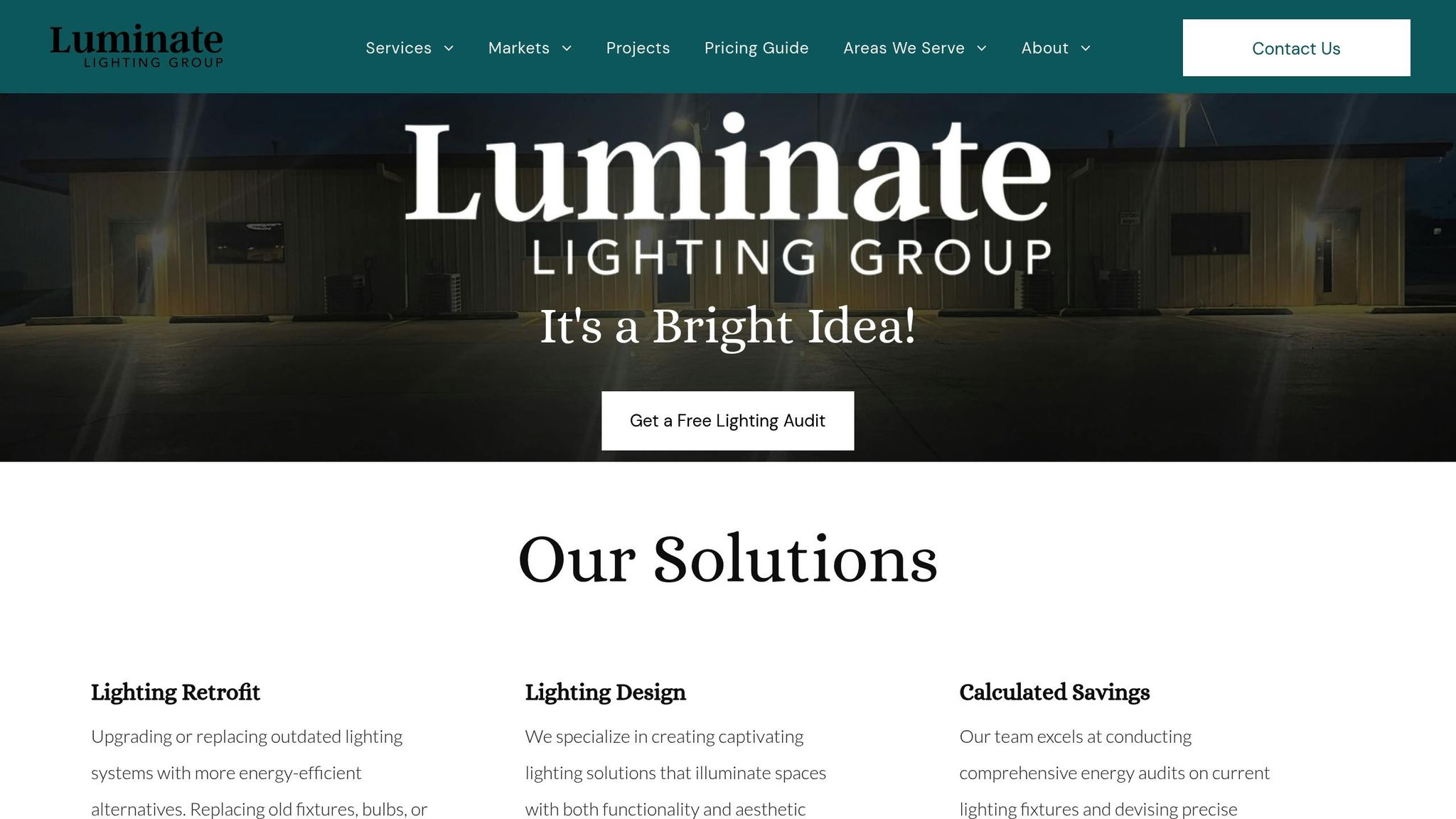
Luminate Lighting Group specializes in LED retrofitting for commercial, industrial, and warehouse spaces across Texas, Oklahoma, and Arkansas. They offer end-to-end solutions, including energy audits, custom designs, and turnkey installations.
A commercial property manager in Tulsa, OK, shared their experience:
"We used Luminate to upgrade all our exterior lighting in a retail center. Their team handled everything - design, install, rebates - and our lot looks incredible at night. It feels safer and more professional."
This project showcases how professional services can elevate outdoor spaces by managing every aspect of the process - design, installation, and even rebate applications. Luminate’s energy audits provide a detailed analysis of existing systems and project potential savings, which can be as high as 85% for large-scale retrofits. Their turnkey approach minimizes disruptions to daily operations while ensuring the lighting system operates efficiently and meets technical requirements. Moreover, their expertise ensures compliance with local codes while optimizing performance.
Meeting Compliance and Quality Standards
One of the key advantages of professional services is their ability to ensure your retrofit meets all relevant regulatory and quality standards. Navigating state and local energy codes can be complicated, but experts help you stay compliant, avoiding potential fines. With lighting accounting for roughly 26% of energy use in commercial buildings - and buildings consuming over 40% of the nation’s energy - LED retrofits are not just a smart upgrade; they’re also financially and legally advantageous.
Professionals also assist in securing state-specific rebates and incentives, maximizing your return on investment. They handle the necessary paperwork for rebate applications and certifications like LEED , providing detailed documentation such as energy modeling results and system specifications. Their energy modeling expertise ensures compliance with standards like ASHRAE and IECC , while commissioning and testing services verify that the system performs as intended. Additionally, UL listing verification ensures you avoid inspection issues down the road.
For larger organizations, Energy Service Companies (ESCOs) offer comprehensive solutions with added performance guarantees. Since 1990, ESCOs have delivered $75 billion in cost savings and reduced CO2 emissions by 560 million tons. As the National Association of Energy Service Companies explains:
"ESCOs have extensive design and implementation experience in integrating multiple efficiency measures, mitigating technical and performance risks, and providing a financial guarantee to project lenders that the energy savings generated will cover the debt service."
Conclusion
Upgrading outdoor fixtures with LED lighting can bring substantial benefits to commercial spaces. These improvements can slash energy usage by 20% to 50% and lower electricity costs by as much as 75%.
But the perks don’t stop at energy savings. LEDs require far less maintenance than traditional bulbs, significantly extending the time between replacements. For commercial buildings, energy-efficient upgrades often yield returns of 10% to 40% of the initial investment.
As LED Light Expert highlighted in January 2025:
"LED retrofitting provides a robust and eco-friendly answer for businesses aiming at energy optimization and better lighting."
While cost savings are a major draw, safety and compliance play an equally important role in a successful retrofit. Complex installations - like those involving ballast-bypass configurations or extensive rewiring - should always be handled by licensed electricians to meet code requirements and avoid potential hazards. One documented case of melted fixtures underscores the risks of improper installation, further emphasizing the need for professional expertise in challenging projects.
Whether managed in-house or outsourced, proper planning and execution are key to achieving the best results. For larger commercial or industrial properties, working with experienced providers like Luminate Lighting Group can make a significant difference. Their end-to-end services, from energy audits to final testing, ensure projects meet regulatory standards, optimize performance, and qualify for rebates - all while minimizing disruptions.
In short, a well-executed LED retrofit combines thoughtful planning, high-quality components, and expert installation to deliver long-term energy savings, improved lighting, and a more sustainable operation. These upgrades are a smart investment for businesses looking to enhance efficiency and reduce costs in their commercial spaces.
FAQs
What should I consider when choosing between plug-and-play and ballast-bypass LED retrofit options?
When choosing between plug-and-play kits and ballast-bypass retrofits, it’s important to weigh a few key factors:
- Ease of Installation: Plug-and-play kits are straightforward to install since they don’t involve rewiring. However, their performance depends on the condition of the existing ballast.
- Long-Term Maintenance: Ballast-bypass retrofits eliminate the need for a ballast entirely, which can reduce the chances of ballast-related failures and lower maintenance expenses over time.
- Energy Efficiency: Ballast-bypass retrofits tend to be more energy-efficient but require rewiring and may involve making changes to the fixture.
Take a close look at your current fixtures and consider your long-term objectives to determine which option aligns best with your needs.
How can my business estimate energy and cost savings from switching outdoor fixtures to LED lighting?
To figure out how much energy you could save, start by comparing the wattage of your current light fixtures to energy-efficient LED options. Take the difference in wattage, multiply it by the number of hours the lights are used each year, and then multiply that by your utility provider’s cost per kilowatt-hour (kWh). LEDs often use up to 70% less energy, which can lead to a noticeable drop in electricity bills.
When calculating cost savings, subtract the yearly energy cost of the new LED fixtures from what you’re currently spending. If you want to determine your return on investment (ROI), add up the upfront costs of the LED fixtures and installation, then divide that total by the annual savings. This gives you the payback period, making it easier to see the long-term financial advantages of switching to LEDs.
What safety steps should I follow when retrofitting outdoor fixtures with LED lighting to avoid electrical hazards and ensure compliance?
Before beginning any retrofit, make sure to disconnect the power- this step is crucial to prevent electrical accidents. For outdoor installations, prioritize safety by using weatherproof fixtures, GFCI protection, and ensuring proper grounding. Choose waterproof connectors to guard against moisture damage, and always stick to the manufacturer's instructions for a reliable setup. Steer clear of DIY soldering, as it can lead to wiring problems down the line. Lastly, conduct regular inspections to confirm that all components are well-insulated and meet safety standards.


